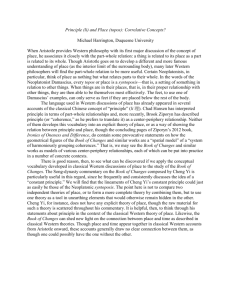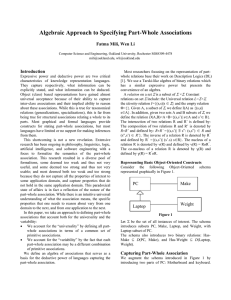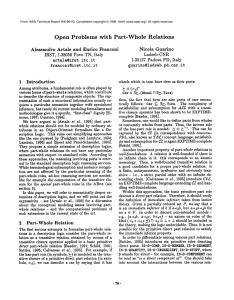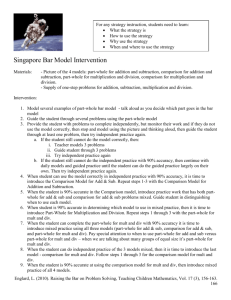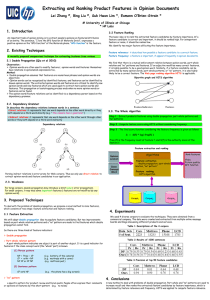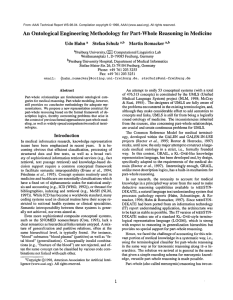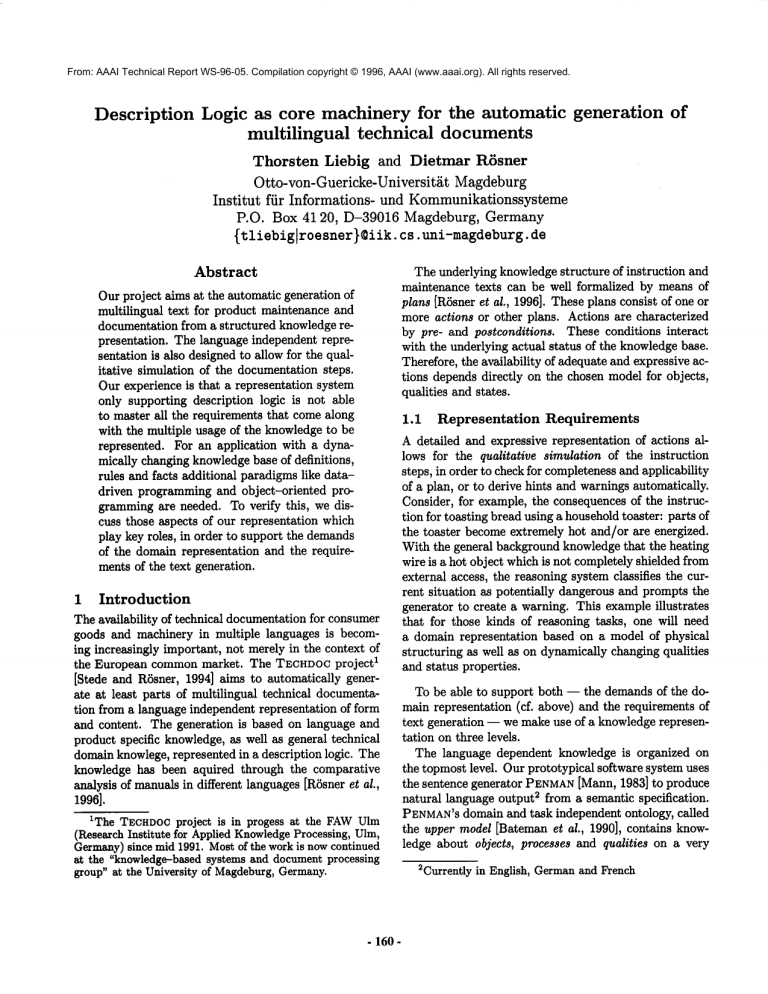
From: AAAI Technical Report WS-96-05. Compilation copyright © 1996, AAAI (www.aaai.org). All rights reserved.
Description
Logic as core machinery for the automatic
multilingual
technical
documents
generation
of
Thorsten Liebig and Dietmar RSsner
Otto-von-Guericke-Universit~it
Magdeburg
Institut fiir Informations-undKommunikationssysteme
P.O. Box 41 20, D-39016 Magdeburg, Germany
{tliebiglroesner}@iik.cs. uni-magdeburg, de
Abstract
Our project aims at the automatic generation of
multilingual text for product maintenance and
documentation from a structured knowledge representation. The language independent representation is also designed to allow for the qualitative simulation of the documentation steps.
Our experience is that a representation system
only supporting description logic is not able
to master all the requirements that come along
with the multiple usage of the knowledgeto be
represented. For an application with a dynamically changing knowledgebase of definitions,
rules and facts additional paradigms like datadriven programming and object-oriented programming are needed. To verify this, we discuss those aspects of our representation which
play key roles, in order to support the demands
of the domain representation and the requirements of the text generation.
The underlying knowledgestructure of instruction and
maintenance texts can be well formalized by means of
plans [RSsner et al., 1996]. These plans consist of one or
more actions or other plans. Actions are characterized
by pre- and postconditions. These conditions interact
with the underlying actual status of the knowledgebase.
Therefore, the availability of adequate and expressive actions depends directly on the chosen model for objects,
qualities and states.
1.1
Representation
Requirements
A detailed and expressive representation of actions allows for the qualitative simulation of the instruction
steps, in order to check for completenessand applicability
of a plan, or to derive hints and warnings automatically.
Consider, for example, the consequences of the instruction for toasting bread using a householdtoaster: parts of
the toaster become extremely hot and/or are energized.
With the general background knowledge that the heating
wire is a hot object which is not completely shielded from
external access, the reasoning system classifies the current situation as potentially dangerous and prompts the
1
Introduction
generator to create a warning. This example illustrates
Theavailability
of technical
documentation
forconsumer that for those kinds of reasoning tasks, one will need
goodsand machinery
in multiplelanguages
is becom- a domain representation based on a model of physical
ingincreasingly
important,
notmerelyin thecontext
of structuring as well as on dynamically changing qualities
I
the Europeancommonmarket.The TECHDOCproject
and status properties.
[StedeandR~sner,1994]aimsto automatically
generateat leastpartsof multilingual
technical
documenta- To be able to support both -- the demands of the dotionfroma language
independent
representation
of form main representation (cf. above) and the requirements
andcontent.
The generation
is basedon language
and text generation -- we make use of a knowledgerepresenproduct
specific
knowledge,
as wellas general
technical tation on three levels.
The language dependent knowledge is organized on
domain
knowlege,
represented
in a description
logic.The
knowledge
has beenaquiredthroughthe comparative the topmost level. Our prototypical software system uses
the sentence generator PENMAN
[Mann, 1983] to produce
analysis of manualsin different languages [RSsner et al.,
2
natural
language
output
from
a
semantic specification.
1996].
domain and task independent ontology, called
1The TECHDOC
project is in progess at the FAWUlm PENMAN’S
the
upper
model [Bateman et al., 1990], contains know(Research Institute for Applied KnowledgeProcessing, Ulm,
ledge
about
objects, processes and qualities on a very
Germany)since mid 1991. Most of the work is nowcontinued
at the "knowledge-based systems and document processing
2Currently in English, Germanand French
group" at the University of Magdeburg,Germany.
- 160-
abstract level. Belowsuch a general, linguistically motivated, classification we have been modelling a level which
we call the middle model. This level contains knowledge
about physical and functional objects (e. g. electrical objects, connections etc.) and their potential states (e.
power-supplied, tightened etc.) in the domain of technical products. Additionally, this level includes the principles which describe how these states can be achieved
and how they influence other objects which are related
together to form a complex whole. Finally, the domain
model represents the lowest level and contains knowledge
about particular technical devices in a concrete application (e. g. the toaster domain).
1.2
Representation
Language
Our experience is that a representation system only supporting description logics is not able to master all the
requirements above. The integration of additional programming paradigms in the representation
system is
therefore a necessary condition, in order to realize adequate models. In our opinion a reasonable representation system must supply an inference engine which successfully integrates frame-like knowledge,as well as rulelike knowledgecombinedwith a generalization of the conception of object-oriented method dispatching.
Weare using the knowledgerepresentation tool called
LOOM[MacGregor and Bates, 1987], a descendent of
the KL-ONEfamily and based on LISP. LOOMis a
good candidate for our representation purpose because
it offers more than just a very powerful description logic. Besides this LOOM
is already used (although not
really exploited) for the upper model of PENMAN.
In addition LOOM
provides powerful deductive support with
forward- and backward-chaining, including both strict
and default reasoning and automatic consistency checking. It also offers procedural programming,a full firstorder query language, production rules, multiple knowledge bases, and object-oriented methods [MacGregor,
19915].
In addition, the empirical analysis of six terminological representation systems in [Heinsohn et al., 1994]
showed LOOMto be the most expressive and fastest
one. 3 However, LOOM’S
inference algorithm is incomplete [MacGregor, 1991a]. This deliberate conceptual
decision of LOOM’S
developers is not surprising since it
has been shown that determining subsumption between
terms, which is needed for the classification process,
is NP-hard [Domini et al., 1991] or even undecidable
[Schmidt-Schaufl, 1989] for reasonably expressive languages.
aThe representation systems were: BACK, CLASSIC,
KRIS, LOOM,MESONand SB-ONE.
- 161-
2
Extending the Modelling Capacities
For any adequate modelling of physical systems, it is
important to identify the relevant phenomena, and to
identify just the appropriate level of detail to modeleach
phenomenon. Hence, a knowledge engineer must have
the a priori information about the inferences to be drawn
in his particular application. Adequate models, therefore, incorporate abstractions and approximations that
are well suited to the problem solving task [Nayak, 1995]
and to the expressiveness, performance and completeness
of the representation system. Moreover, the representation should conform to the crucial modelling quality
factors of object-oriented systems: reusability, understandability and extensibility [Meyer, 1988].
To identify the relevant phenomenaand the appropriate level of detail, we focused our objects from a functional and structural perspective, we will not address
here (but cf. [Liebig and RSsner, 1996]).
2.1 Part-Whole
Relations
The part-whole relation plays a fundamental role in the
description of complex objects. This relation can be
found in many different
domains. As in Franconi’s
[Franconi, 1993] proposal, we model the part-whole relationship as a reflexive, anti-symmetric and transitive
relation ~:
W.~ (x, x).
Vx, y. ~- (x, y)A~ (y, x) --+ x
vx,y, z. ~ (x, y)A~_(y, z) -~- (x,
As in Sattler’s [Sattler, 1995] concept language ~ for
engineering applications, our part-whole relations are
direct part-whole relations in the sense that they must
satisfy the immediate inferior definition. 4 As noted in
[Artale et al., 1995], this constraint should affect the
ABoxreasoning process in order to discard non-intended
models. In contrast to Sattler’s application, which lacks
ABoxreasoning, we use data-driven rules in order to
conform to the above definitions of immediate inferiors and anti-symmetry. These rules observe the actual
knowledge base and cause a warning whenever an assertion violates a particular definition.
As discussed in [Artale et al., 1995], part-whole relations cannot simply be modelled by ordinary attributes
like price or color. The representation formalism should
take their specific meaning and their transitivity rules
into account. To illustrate
this, consider the example
taken from [Artale et at., 1995]: "an arm is part of a musician, the musician is part of an orchestra, but it would
sound a bit strange to state that the arm is part of the
orchestra". The inacceptability of this inference is due
4Givena partially ordered set P, we say that a is an immediate inferior of b if a < b and there does not exist an
x E P such that a < x < b.
to a mixing of two different interpretational meanings of
the the part-whole relation.
Winston, Chaffin and Herrmann [Winston et al., 1987]
proposed a distinction between six kinds of specialized part-whole relations to overcome such problems:
Component/Integral-Object,
Member/Collection, Portion/Mass, Stuff/Object, Feature/Activity
and Place/
Area.
These distinctions allow more suggestive reasoning
mechanisms along the part-whole relationships,
as far
as one single kind of relation is involved. 5 All specific
part-whole relationships are modelled as specializations
of a general part-whole relation. The transitive version
of this relation does, therefore, hold between parts and
wholes which have chains of different kinds of part-whole
relations between them.
To determine transitive part-whole relationships we
have defined additional relations capturing the transitive
8closure of each of the relations above.
The most important part-whole relationship
in our
context is between integral-objects which have a structure, and their components which have a specific functionality and which are separable.
Part-whole relations can be also defined as essential.
Instances in the range of essential relations are then automatically classified as essential-parts. This allows for the
automatic determination of relevant components in order
to support the knowledgeengineer in building up his domain. Knowledgeabout essential parts is available at
concept level, so even when there are no instances created, the user can ask for the essential parts of a specific device (example in [Liebig and tt6sner, 1996]).
continue in this direction, we propose automatic generation of all essential parts wheninstantiating the respective whole. In order to have a generic function for this
purpose, it is necessary to generalize the conception of
object-oriented method dispatching to concepts and relations.
2.2 Functional
Aspects
The representation we propose combines structural and
functional information about a complex object (e. g.
device). As discussed in [Keuneke, 1991], functional
structuring is useful for problem-solving mechanisms,
which must often decompose the device’s function into
the functicion of the components.The functional specification describes the device’s goals at a level of abstraction
that is of interest at the object level [Keuneke,1991].
SHowever,the compositionof different part-whole relations can have relevant meaningstoo, but not in all cases
(see composition
table in [Sattler, 1995]).
eThedefinition of the transitive closure includesthe filtering of the reflexivity property of the part-wholerelations in
order to prevent cyclic paths. For a detailed discussion see
[Liebig andttSsner, 1996].
- 162-
We use a model based on a structural organization
enriched with functional components. The function of
a device is its intended purpose, which is achieved by
behaviours [Keuneke, 1991]. Our model represents behaviour as the causal sequence of transitions of partial
states/predicates. Determining the actual states depends
on the individual abstract object. An electrical control
appliance has, for example, the status "on" if all of its
componentsare in a status in which they close the underlying electrical circuit. The control appliance of electrical
devices usually consists of a set of switches. These different kinds of switches (e.g. binary switch, tune etc.) can
be adjusted by using a generic action. This action must
be applicable to all kind of switches and should therefore
use object-oriented method dispatching, generalized to
the purposes of description logics.
In order to capture the essentials of complexobjects we
need to express "vertical" and "horizontal" relationships
and constraints.
2.3
Vertical
Inheritance
Vertical dependencies can be differentiated into relationships betweenthe existence of the whole and the existence
of certain parts, and relationships between the properties
of a whole and the properties of its parts [Simons, 1987].
Existential dependencies have been addressed by proposing relations as essential.
The class of relationships between the properties of a
whole and the properties of its parts (and vice versa) can
be differentiated into [Artale et al., 1995]:
(a) Properties which the parts inherit from the whole.
(b) Properties which the whole inherits from its parts.
(c) Properties of the parts which are systematically related to properties of the whole (These are not yet
captured in our model).
Wedescribe the first two varieties in turn:
(a) The location is a property which parts inherit from
the whole (with respect to a certain granularity). In order to inherit properties of this kind we have written
macros expressing Franconi’s [Franconi, 1993] left and
right distributive quantifiers for relations from his language A£CS:
<~ C.R(a, b) iff Vx.(_ (a, x) C(x)) ~ R(x, b)
t> C.R(a, b) if[ Vx.(_ (b, x) C(x)) -- + R(a, x)
The operators <~ and E> express the left and right distributive readings. They can be qualified by a qualification predicate C, which was omitted in our macros
(formally we assume C -= T). These macros extend the
description logic by adding backward-chaining implication rules to the knowledge base. Figure 1 shows the
inheritance of a property represented by the relation R.
Thetemperaturestatus of the toaster, therefore, is influencedby the temperatureof the heating wire in a vertical
manner.
2.5 Temporal Aspects
In a first version of the knowledgebase switching the
toaster "on" or "off" does immediatlyinfluence the temperature status of the heating wire and the toaster.
However,this does not modelthe real world adequately
to be able to derive knowledgeabout hot objects. For
example,the heating wire does not becomehot until it
has been energized for a little while. Analogously,the
wire remainshot for a few minutesafter it is no longer
energized.
To capture these regularities, one will needa description logic with temporal extensions. LOOM’s
extension
for temporal concepts and relations allows us to make
factual assertions about role fillers and instances that
hold only over specified intervals, rather than being universally true.
A drawbackof the current version of LOOM:
it was
not possible to express somerelevant temporal dependencies in concept or relation definitions directly. We
wereforced to write production rules in order to detect
relevant temporal changes in the knowledgebase. The
correspondingexplicit temporal assertions were placed
in the action parts of these rules.
/
/
Figure1: Thethin lines indicate the part-wholerelations
(~_); the dashedline represents the relation R which
inherited (dotted arrows) left-distributive to all parts
a (displayed for x only).
Since we also express properties in form of concepts,
we extend the qualified plural quantifiers with a distributive reading for concepts:
oD(a) if[ Vx. ~ (a,x).
~ D(x)
(b) Properties whichthe wholeinherits fromits parts
are, in the domain of a household toaster, "on" or
"power-supplied". In order to inherit these properties upward, we have written macros which expand to backward-chainingimplication rules, similar to
Frauconi’squalified plural quantifiers, but based on the
inverse of the part-wholerelation.
2.4
Horizontal Inheritance
Horizontal relationships are composedof constraints
amongparts which characterize the integrity of the
whole. Although they are important for capturing the
notion of a whole, they find little attention in current
modellingformalisms[Artale et al., 1995].
To determinethe energized or hot parts of a device,
for example,it is necessaryto modelthe electrical connections of the componentsof the device. In order to
recognize an electrical object as energized, the reasoning mechanismmust find those objects which have an
electrical connnectionto an internal or external power
supply. Additionall, the status of any switchon this path
must be taken into account. The determination of this
path along the electrical connection betweenobjects is
directly encodedin LISP as a depth-first search extended with additional filtering procedures.
Concluding
Remarks
3
As a guideline for structuring complexobjects, wepropose a model using a physically oriented organization
enrichedwith functional extensions. The transitive partwholerelation andthe ability to inherit properties vertically andhorizontally play keyroles in this structuring.
This skeleton can be usedas a basis for a large variety
of different modelling purposes, not only in the domain
of technical products. Imagine, for example, the modelling of a structured organisation: their administration
processes and the inheritance of competencesand tasks.
Horizontalandvertical inheritance often influence each
other in order to create complexdependencies. For example, the temperature status of the heating wire depends on the horizontal constraint of being energized.
- 163-
Wehave enriched the representation languagein order
to simply enable upwardsor downwardsinheritance of
conceptsor relations.
In order to reject unintended models, we use ABox
reasoning. For this purpose we neededproduction rules
suitable for triggering conceptsand relations.
Object-oriented methods, gerneralized for concepts
andrelations, wereneededfor generically applicable creation or adjust methods.
In our opinion, descriptionlogic can only build the core
of a programming
envionmentwhichfulfills the requirementsthat camealong with the multiple uses (text generation, qualitative simulationetc.) of the knowledge
to be
represented. Additional paradigmslike data-driven programmingand object-oriented programmingare needed.
Indeed, theses paradigmshave to be carefully integrated
into the description languagewithout missing important
classes of inferences.
Suggestions for future workinclude a moreconformed
integration of temporalextensions into the model.Since
manyproperties are time-dependent,it seemsinadequate
to write production rules for every particular temporal
conceptor relation in order to assert temporalfacts.
References
[Artale et al., 1995]AlessandroArtale, Enrico Franconi,
Nicola Guarino, and Luca Pazzi. Part-whole relations in object-centered systems: An overview. Data
KnowledgeEngineering - North-Holland, Elsevier,
December1995.
[Bateman et al., 1990] John A. Bateman, Robert T.
Kasper, Johanna D. Moore, and Richard A. Whitney.
A general organization of knowledgefor natural language processing: the penmanupper model. Technical
report, ISI, 1990.
[Dominiet al., 1991] F. Domini,M. Lenzerini, D. Nardi,
and W. Nutt. The complexity of concept languages.
In J. F. Doyle, R. Files, and Erik Sandewall,editors,
Principles of KnowledgeRepresentation and Reasoning, Proceedingsof the SecondInternational Conference (KR’9I), pages 151 - 162, Cambridge,MA,April
1991. MorganKaufmannPublishers, Inc., San Francisco, CA.
[Franconi, 1993] Enrico Franconi. A treatment of plurals
and plural quantifications based on a theory of collections. Mindsand Machines, 3:453 - 474, 1993.
[Heinsohnet al., 1994] Jochen Heinsohn,Daniel Kudenko, BernhardNebel, and Hans-Jiirgen Profitlich. An
empirical analysis of terminologicalrepresentationsystems. Artificial Intelligence, 68(2):367- 398, 1994.
[Keuneke, 1991] AnneM. Keuneke. Device representation, the significance of functional knowledge.IEEE
EXPERT,pages 22 - 25, April 1991.
[Liebig and Riisner, 1996] Thorsten Liebig and Dietmar
RSsner. Modelling of reusable product knowledgein
terminological logics: a case study. In Proceedingsof
the First International Conferenceon Practical Aspects of Knowledge Management,-- to appear --,
1996.
[MacGregor and Bates, 1987] R. MacGregorand R.
Bates. The LOOM
knowledge representation language. Technical report, ISI/RS-87-188, ISI, University of SouthernCalifornia, 1987.
- 164-
[MacGregor, 1991a] Robert M. MacGregor. Inside the
LOOM
Description Classifier.
SIGART Bulletin,
2(3):88 - 92, June 1991.
[MacGregor,1991b] Robert M. MacGregor.Using a description classifier to enhancedeductiveinference. In
Proceedings of the Seventh IEEE Conference on AI
Applications, pages 141 - 147, 1991.
[Mann,1983] William C. Mann.An overview of the PENMAN
text generation system. In Proceedingsof the National Conferenceon Artificial Intelligence, pages 261
- 265. AAAI,August 1983.
[Meyer, 1988] B. Meyer. Object-oriented Software Construction. Prentice Hall, NewYork, 1988.
[Nayak, 1995] P. Pandurang Nayak. Automated Modeling of Physical Systems. Number1003 in Lecture
Notesin Artificial Intelligence. Springer Verlag,Berlin, 1995.
[RSsner et al., 1996] Dietmar RSsner, BjSrn HSfiing,
and Knut Hartmann. From natural language documents to sharable product knowledge. In Proceedings of the First International Conferenceon Practical
Aspects of KnowledgeManagement,-- to appear --,
1996.
[Sattler, 1995]Ulrike Sattler. Aconcept languagefor an
engineering application with part-whole relations. In
A. Borigida, M. Lenzerini, D. Nardi, and B. Nebel,
editors, Proccedingsof the International Workshopon
Description Logics, pages 119- 123, Rome,Italy, June
1995.
[Schmidt-Schaufl, 1989] M. Schmidt-Sehaufl. Subsumption in KL-ONE
is undeeidable. In H. J. Levesque
and R. Reiter, editors, Principles of KnowledgeRepresentation and Reasoning, Proceedingsof the First
International Conference(KR ’89), pages 421 - 431,
Toronto, ON, May1989. MorganKaufmannPublishers, Inc., San Francisco, CA.
[Simons, 1987] Peter Simons. Parts: A Study in Ontology. ClarendonPress, Oxford, 1987.
[Stede and R~Ssner, 1994] ManfredStede and Dietmar
R~Ssner. Generating multilingual documents from
a knowledge base: The TECHDOC
project.
In
COLING-9,~,
Proceedings, Kyoto, 1994.
[Winstonet al., 1987] MortonWinston, RogerChaffin,
and Douglas Herrmann. A taxonomy of part-whole
relations. Cognitive Science, 11:417-444,1987.

